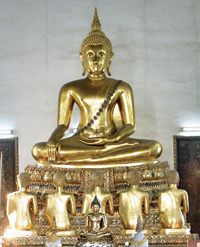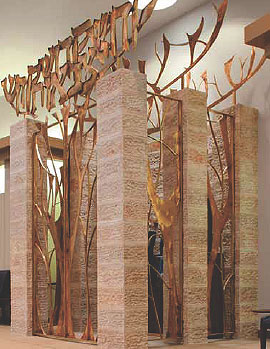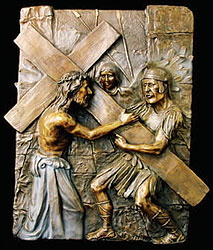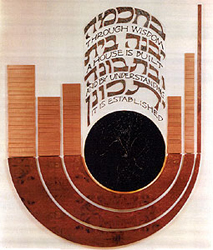Heavenly Copper
 Gilded bronze statue in a Buddhist temple.
Gilded bronze statue in a Buddhist temple.It would be difficult to imagine houses of worship without copper, brass or bronze. The aesthetic and durable metals are found in interior as well as exterior uses and often used for sacred vessels, statuary and decoration - and even most church bells rely on bronze (modern, electronic chimes rely on copper-wired circuits).
In many instances, the redmetal applications can be appreciated by passersby, because the roofs, doors and other exterior elements are made of copper and copper alloys. For example, the walls and roof of the St. Boniface Episcopal Church in Mequon, Wisconsin, are clad in copper.
The church was designed by James Shields of Hammel, Green and Abrahamson, Milwaukee. Shields exclaims copper's longevity, patina change over time and its sheer beauty. Christensen Roofing of Milwaukee installed the 19,000 pounds of 16-ounce copper in seven weeks.
The copper roof on Saints Joseph and Andrew Orthodox Church in Candler, North Carolina, won't have the typical reddish, earthen coloring that would change over the years to a bluish green. That's because the copper is coated. Architect Joseph P. Parimucha wanted to reflect the design of early Byzantine churches that had lead roofs. As he puts it, "Because lead roofs are no longer possible, I selected lead-coated copper."
Sheet copper is available in many varieties: colors, coatings, textures and even pre-patinated for those who can't wait for nature to take its course. And, as the architects point out, it can be applied in a number of ways: standing seam, batten seam, flat seam, shingles and other imaginative and attractive forms. Hundreds of examples abound both here in the USA and abroad.
Nonstructural Elements
 The Ark at Temple Oheb Shalom, Baltimore, designed by Levin/Brown Associates. The bronze grillwork was made by David Klass.
The Ark at Temple Oheb Shalom, Baltimore, designed by Levin/Brown Associates. The bronze grillwork was made by David Klass. Photo courtesy of Alan Gilbert Photography, www.alangilbertphotography.com
Copper alloys are not limited to structural elements in houses of worship. In a renovation of the St. Joseph Catholic Church in Richardson, Texas, Dallasbased architect Jane Landry added a large baptismal font made of limestone enclosing a stepped bronze pool over which water gently flows. Candelabras and other lighting are typically brass or copper. Synagogues have brass finials topping the central wooden rods of sacred scrolls. Vessels and repositories containing sacred scriptures and artifacts are usually polished brass or copper (often gilded).
One of the more striking interior applications of bronze is in the Ark of Temple Oheb Shalom in Baltimore. Designed by Mark Levin of Levin/Brown Associates, Owings Mills, Maryland, the open Ark, constructed of six pylons of hewn Jerusalem stone supporting bronze grillwork, is entered via a bronze gate. All of the bronze was created by sculptor David Klass of New York.
And in most houses of worship there are brass or bronze plaques on the walls honoring donors and deceased members and ministers. The illustrated "donor wall" is at the Woodbury Jewish Center, New York. It was fabricated by Presentations Gallery, Mount Vernon, New York.
 A copper bas relief depicts one of the Stations of the Cross. Made by Kircher & Associates, Jaroso, Colorado.
A copper bas relief depicts one of the Stations of the Cross. Made by Kircher & Associates, Jaroso, Colorado. Donor Wall in the lobby at the Woodbury Jewish Center, New York, fabricated by Presentations Gallery.
Donor Wall in the lobby at the Woodbury Jewish Center, New York, fabricated by Presentations Gallery.Christiansen:
414-445-4141;
www.christiansenroofing.com
Hammel, Green:
414-278-8200;
www.HGA.com
Huelat Parimucha:
703-838-8414;
www.healingdesign.com
Kircher & Associates:
719-672-3063;
www.kirchersculpture.com
Klass:
212-243-7622;
www.synagogueart.com
Also in this Issue:
- Heavenly Copper
- Copper Could Help Counter Health Crisis
- Lady Liberty Provided Copper for Chopper
- Copper to Reveal Comet’s Makeup
- Motor Swaps Save Big
